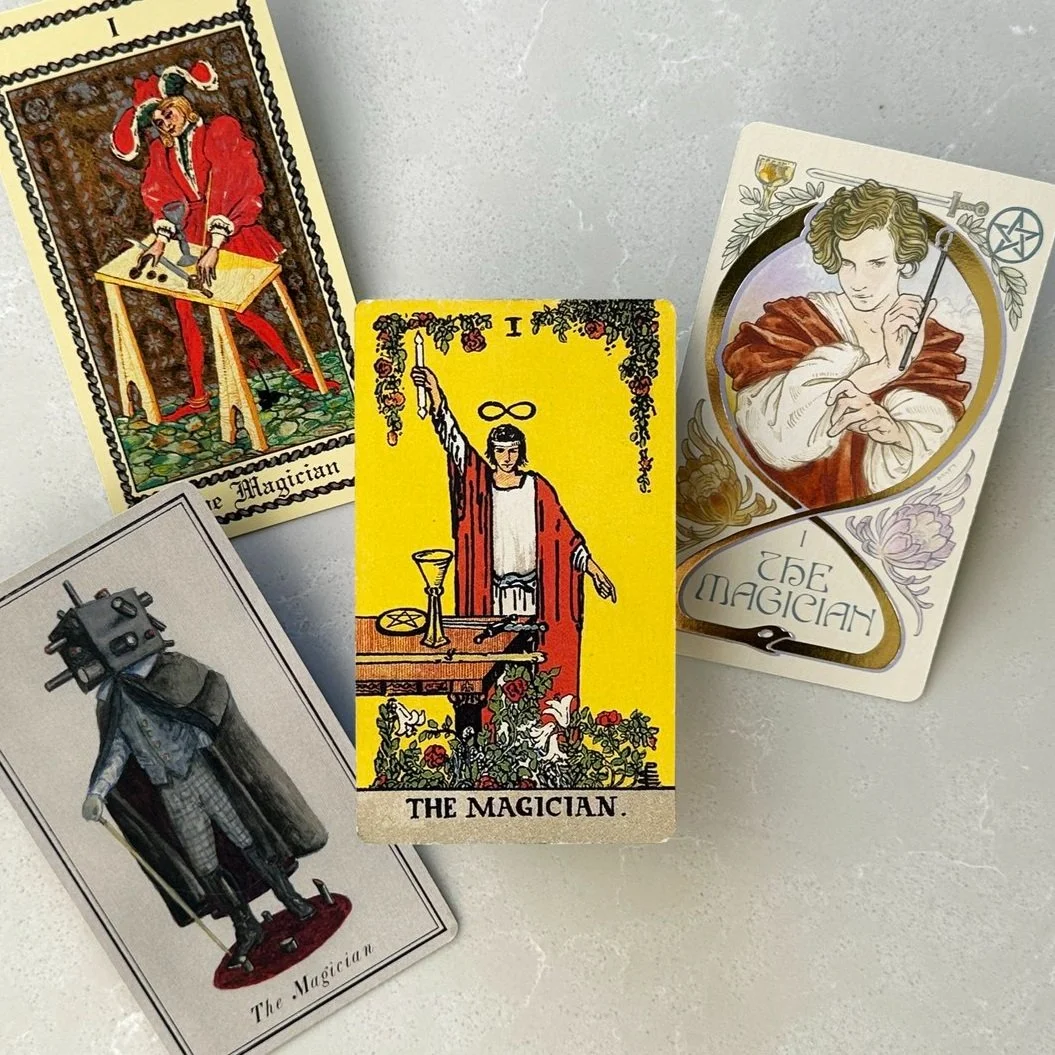Making Magic in February
How does The Magician’s ability to manifest his desires into the world express itself in the cards?
Growing up in the mid-90’s, I had an incredible obsession with televised magic shows, specifically The World’s Greatest Magic. Airing from 1994 to 1998, the television specials included performances from Penn & Teller, David Copperfield, Lance Burton, Peter Marvye…the list goes on. Reflecting on this early infatuation, I can’t help but link these harbingers of “magic” to the solitary practitioner that lives within the four sides of Tarot card number one. Regardless of which realm our Magician of choice lives, all are superior directors of energy. Whether picking up the wand, channeling the Divine by tapping into the four elements, or using sleight of hand to divert an audience's attention, both parties have the ability to manifest specific results that align to their own desires.
In this exploration of the visual nuances seen within The Magician, I have selected the Carnival at the End of the World Tarot by Kahn & Selesnick, The Medieval Scapini Tarot by Luigi Scapini, Smith-Waite Borderless by Arthur Waite and Pamela Coleman Smith, and the Ethereal Visions Tarot by Matt Hughes.
A selection of Magicians from my deck collection. Clockwise from bottom left: The Carnival at the End of the World (Kahn + Selesnick), Medieval Scapini Tarot Deck (Luigi Scapini), Smith-Waite Borderless (Arthur Edward Waite and Pamela Colman Smith), and The Etheral Vision Illuminated Tarot Deck (Matt Hughes)
Before we dive in on the overall imagery, let’s take a step back and look at the color of these Magicians. What color unites them all? Red! Clothing, carpet, foliage…red stands a through line for each of these cards. Historically in the Tarot, red is often viewed as a symbol of life and passion as its the color of blood. The substance courses through our veins, delivering vitality to all of our appendages and organs. It is also the color of manifestation and birth. As humans, we enter into this world very fresh, covered in life-giving crimson, and filled with potential. And this is the power of our Magician. He is the spark that brings the potential into the physical
Now let’s turn our attention to the wares of the Magician, specifically what he places on his shoulders. Whether it is a commanding jacket with dynamic sleeves (as seen in the Medieval Scapini Tarot) or a mysterious cloak used to hide eternal, infinite secrets, each of these Magician’s taste in clothing suggests they understand the importance or their role in society. Medicine men, sages, soothsayers—all of them had a particular way of dressing within their respective times and cultures to denote a certain stature and, more importantly, a connection to something beyond themselves. But outside of just “looking the part”, our Magicians wield a specific tool to direct their powerful connected energy. Throughout time, wands have been the pointers of magic and of power. Think of a musical conductor’s baton—lifting it above a symphony to bring forth the grandest of sounds or the softest of tunes. Or even a film director, framing up what the audience is able to see, hear, think, and ultimately feel. The Magician of the Carnival at the End of the World Tarot is just that. His wand might not be one of a stick-like sense persuasion, but the lenses he wields on his head permit him to direct our vision just the same.
However, wands are not the only tool most Magicians use. Pentacles, cups, and swords are also vital to the success of any Magician’s practice. But you’ll notice that some of these tools are missing from the altars depicted in the cards. Perhaps the suggestion that the physical embodiment of the four elements might not be the source of true power in each artist’s depiction. Furthermore, our same lens-headed friend from the Carnival at the End of the World Tarot only carries a cane. The challenge of making sure each and every Magician is equipped with the proper tools seems to be limited to a few of the artists. If we think of these early sages as primitive folk, living off of the land in a communal and more cooperative manner, the four tools of pentacle, cup, sword, and wand, might feel too human, too limiting. If The Magician is in fact a master of harnessing the elements, shouldn’t he be able to tap into them without the use of tools?
Another outstanding contrast among these four depictions of The Magician is their stances. Whether he’s standing confidently in Carnival, placing his steadied hands on an altar in Scapini, emphatically gesturing to the sky and the ground in Waite-Smith, or posing defensively in Ethereal Visions, the body language is indicating tells 4 separate stories, all valid in their own ways. For instance, in the last card on the right, our Magician looks as if he is on the defense, ready to cast a powerful spell on an assailant who challenges his ways. Perhaps this Magician is protecting those who stand behind him, or maybe he’s shielding himself from those who seek to steal his connection with the elements. Whatever the case may be, we understand this man to be at the ready, prepared for the unexpected.
As we start to get our bearings in 2023, let us meditate on The Magician and his ability to manifest, not only desires for himself but for those who look to us as a source of unbridled power, quiet strength, and a steward of the Divine as well.

